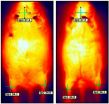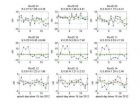(Press-News.org) Most mammals, including humans, see in stereo and hear in stereo. But whether they can also smell in stereo is the subject of a long-standing scientific controversy.
Now, a new study shows definitively that the common mole (Scalopus aquaticus) – the same critter that disrupts the lawns and gardens of homeowners throughout the eastern United States, Canada and Mexico – relies on stereo sniffing to locate its prey. The paper that describes this research, "Stereo and Serial Sniffing Guide Navigation to an Odor Source in a Mammals," was published on Feb. 5 in the journal Nature Communications.
"I came at this as a skeptic. I thought the moles' nostrils were too close together to effectively detect odor gradients," said Kenneth Catania, the Stevenson Professor of Biological Sciences at Vanderbilt University, who conducted the research.
VIDEO:
Vanderbilt neuroscientist Kenneth Catania designed a series of tests which demonstrated that the eastern mole relies of stereo sniffing to locate its prey.
Click here for more information.
What he found turned his assumptions upside down and opened new areas for potential future research. "The fact that moles use stereo odor cues to locate food suggests other mammals that rely heavily on their sense of smell, like dogs and pigs might also have this ability," Catania said.
Catania's interest in the common mole's sense of smell dates back ten years when he was studying the remarkable sense of touch of the common moles' cousin, the star-nosed mole, which uses a set of fleshy tentacles surrounding its nose to detect edible objects as it burrows. He decided to test the common moles' capability to find prey for comparison purposes. "I expected the common mole, which is virtually blind and doesn't have a very good sense of touch, to be a lot worse than the star-nosed mole. So I was quite surprised when they turned out to be very good at locating prey. At the time, I figured that they must be using their sense of smell, but I didn't pursue the matter."
When the neuroscientist began seriously studying the common moles' sense of smell last year, he discovered that it was even more remarkable than he had expected.
He created a radial arena with food wells spaced around a 180-degree circle with the entrance for the mole located at the center. He then ran a number of trials with the food (pieces of earthworm) placed randomly in different wells. The chamber was temporarily sealed so he could detect each time the mole sniffed by the change in air pressure.
"It was amazing. They found the food in less than five seconds and went directly to the right food well almost every time," Catania said. "They have a hyper-sensitive sense of smell."
After observing dozens of trials, he noticed a general pattern. When the mole first entered the chamber, it moved its nose back and forth as it sniffed, but then it seemed to zero in on the food source, and moved in a direct path. This was pretty remarkable, and made Catania reconsider the idea of stereo sniffing. Although there is evidence for this ability in stationary rats trained to detect flowing air, no one had shown how this might work for a natural behavior.
To further investigate the moles' sense of smell, Catania blocked one of the moles' nostrils with a small plastic tube. When their left nostrils were blocked, the moles' paths consistently veered off to the right and when their right nostrils were blocked, they consistently veered to the left. They still found the food but it took them significantly longer to do so.
Next, the researcher designed a chamber where the food was always placed in the same position, directly across from the entrance. Moles using both nostrils went almost directly to the food, but the path of those with their left nostrils blocked was consistently to the right of the direct path and that of those with the right nostrils blocked was consistently to the left.
"This is strikingly similar to a landmark study of hearing in barn owls performed in 1979 by Eric Knudsen and Mark Konishi at the California Institute of Technology, who found that blocking one of the owl's ears caused them to misjudge the location of a sound source," Catania said.
The definitive evidence that the moles rely on stereo sniffing came from yet another test. Catania inserted small plastic tubes in both of the moles' nostrils and crossed them, so the right nostril was sniffing air on the animal's left and the left nostril was sniffing air on the animal's right. When their nostrils were crossed in this fashion, the animals searched back and forth and frequently could not find the food at all.
As for humans, Catania remains skeptical. "In humans, this is easier to test because you can ask a blindfolded person to tell you which nostril is being stimulated by odors presented with tubes inserted in the nose." Such studies suggest it is only when an odor is strong enough to irritate the nostril lining that humans can tell which side is most strongly stimulated.
INFORMATION:
Visit Research News @ Vanderbilt for more research news from Vanderbilt. [Media Note: Vanderbilt has a 24/7 TV and radio studio with a dedicated fiber optic line and ISDN line. Use of the TV studio with Vanderbilt experts is free, except for reserving fiber time.]
-VU-
Evidence that at least 1 mammal can smell in stereo
2013-02-05
ELSE PRESS RELEASES FROM THIS DATE:
Using single quantum dots to probe nanowires
2013-02-05
Modern telecommunications happens because of fast electrons and fast photons. Can it get better? Can Moore's law---the doubling of computing power ever 18 months or so---be sustained? Can the compactness (nm-scale components) of electronics be combined with the speed of photonics? Well, one such hybrid approach is being explored at the Joint Quantum Institute (*), where scientists bring together three marvelous physics research fields: microfluidics, quantum dots, and plasmonics to probe and study optical nanostructures with spatial accuracy as fine as 12 nm. ...
Fighting fat with fat: Stem cell discovery identifies potential obesity treatment
2013-02-05
February 5, 2013—Ottawa—Ottawa scientists have discovered a trigger that turns muscle stem cells into brown fat, a form of good fat that could play a critical role in the fight against obesity. The findings from Dr. Michael Rudnicki's lab, based at the Ottawa Hospital Research Institute, were published today in the prestigious journal Cell Metabolism.
"This discovery significantly advances our ability to harness this good fat in the battle against bad fat and all the associated health risks that come with being overweight and obese," says Dr. Rudnicki, a senior scientist ...
Mammogram every 2 years has same benefit as yearly mammogram for older women, UCSF study finds
2013-02-05
Among older women, getting a mammogram every two years was just as beneficial as getting a mammogram annually, and led to significantly fewer false positive results, according to a study led by UC San Francisco.
The national study of more than 140,000 women between the ages of 66 and 89 appears online February 5, 2013, in the Journal of the National Cancer Institute.
"Screening every other year, as opposed to every year, does not increase the probability of late-stage breast cancer in older women," said lead author Dejana Braithwaite, PhD, a UCSF assistant professor ...
Cargo container research to improve buildings' ability to withstand tsunamis
2013-02-05
Anyone who has seen the movie "Impossible" or watched footage from the Japanese tsunami has learned the terror that can strike with little warning. In those cases, when there is no time to flee, there may still be time to reach higher ground, called vertical evacuation.
But as you race to the third floor, how do you know if the building will hold up? Walls of water are not the only danger. Another potentially lethal challenge is water-driven debris - such as 60,000-pound fully loaded cargo containers - transformed into projectiles. Often pulled behind semi-trucks on highways, ...
Olive oil component alleviates intestinal ischemia and reperfusion
2013-02-05
Here's another reason why you should include olive oil in your diet: A new research report published in the Journal of Leukocyte Biology suggests that at least one compound in olive oil significantly reduces intestinal ischemia (restricted blood supply) and the resulting reperfusion injury (tissue damage caused when blood supply returns). The compound, called "oleuropein aglycone," is the most prominent polyphenol found in olive oil and could become a novel therapeutic target aimed at treating intestinal ischemia and reperfusion injury in humans. Ultimately, this research ...
Flexible classroom design saves money, improves flexibility, accessibility of instruction
2013-02-05
Researchers at North Carolina State University have developed a classroom design that gives instructors increased flexibility in how to teach their courses and improves accessibility for students, while slashing administrative costs.
Specifically, the new classrooms take advantage of the fact that students are bringing their own technology – such as laptops – to class. The classrooms also include mobile infrastructure, where whiteboards, desks and tables can be reconfigured according to the needs of students and instructors.
"These classrooms work really well in terms ...
Chest pain prior to a heart attack can protect the heart
2013-02-05
MINNEAPOLIS, MN – Feb. 5, 2013 – Patients who experience chest pain in the 24 hours preceding a heart attack, also called preinfarction angina, have smaller heart attacks and improved cardiac function in the contemporary cardiac stenting era, researchers found in a study published Jan. 22 in Circulation: Cardiovascular Interventions.
"Even before we began treating heart attack patients with angioplasty and stenting, physicians recognized that patients with chest pain prior to their heart attack seem to have better outcomes," says the study's senior author, Jay H. Traverse, ...
Precise Point Positioning and real-time positioning accuracy for COMPASS satellite navigation
2013-02-05
COMPASS uses the Geostationary Earth Orbit (GEO) and Inclined Geosynchronous Satellite Orbit (IGSO) satellites, which are more suitable for regional services. Its constellation is composed of 14 satellites, including 5 GEO, 5 IGSO satellites and 4 Medium Earth Orbit (MEO) satellites. As of 2012, 13 satellites have been launched. Except for G2 (unusable) and M1 (testing only), the remaining 11 satellites, including 4GEO+5IGSO+2MEO, have successfully transmitted signals and broadcasted navigational messages, to prepare for full operation starting in 2013.
Positioning accuracy ...
The zebrafish revealed a central regulator for the development of the brain histamine system
2013-02-05
Research has shown that mutations in the psen1 gene are common in the familial forms of Alzheimer's disease, and the Presenilin-1 protein that the gene encodes is known to be involved in the cleavage of the amyloid precursor protein. In Alzheimer's disease the amyloid precursor protein is not cleaved the normal way, and the protein accumulates in the brain damaging neuronal tracts and neurons. It is still unknown if the psen1 gene is involved in the etiology of Alzheimer's disease via another mechanism.
Professor Pertti Panula's research team at the University of Helsinki ...
Growth arrest in prostate cancer
2013-02-05
A previously poorly investigated signalling pathway is crucial for the growth and proliferation of prostate cancer cells. An international research team discovered this when studying the enzyme "soluble adenylyl cyclase" that produces the second messenger molecule cAMP. When the scientists inhibited the enzyme, the cancer cell proliferation was suppressed. The team led by Dr. Yury Ladilov from the Department of Clinical Pharmacology at the Ruhr-Universität Bochum reported together with colleagues from the Department of Urology at the RUB and the Cornell University in New ...




